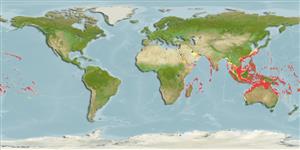Classification / Names
Common names from other countries
Main reference
Size / Weight / Age
Max length : 90.0 cm TL male/unsexed; (Ref. 9987); common length : 76.0 cm SL male/unsexed; (Ref. 37816); max. published weight: 12.5 kg (Ref. 4699); max. reported age: 55 years (Ref. 72420)
Length at first maturity
Lm 42.9, range 39 - ? cm
Environment
Marine; freshwater; brackish; reef-associated; depth range 4 - 180 m (Ref. 37816), usually 10 - 70 m (Ref. 30573)
Climate / Range
Tropical, preferred 28°C (Ref. 107945); 31°N - 33°S, 31°E - 128°W (Ref. 55)
Distribution
Indo-Pacific: East Africa to the Marquesas and Line islands, north to the Ryukyu Islands, south to Australia. More common around oceanic islands than in continental areas.
Countries | FAO areas | Ecosystems | Occurrences | Introductions
Short description
Dorsal
spines
(total): 10;
Dorsal
soft rays
(total): 13-14;
Anal
spines: 3;
Anal
soft rays: 8. Snout somewhat pointed. Dorsal profile of head rounded. Preorbital bone relatively broad; its width usually greater than eye diameter. A deep groove or pit runs from the nostrils to the front of the eye. Preopercular notch and knob moderately developed. Scale rows on back rising obliquely above lateral line. Young and some adults with two silvery-white spots on back. Large adults mostly plain red (Ref. 48635).
IUCN Red List Status (Ref. 115185)
Threat to humans
Reports of ciguatera poisoning (Ref. 4690)
Human uses
Fisheries: commercial; gamefish: yes
Tools
Special reports
Download XML
Internet sources
Estimates of some properties based on models
Phylogenetic diversity index
PD50 = 0.5000 many relatives (e.g. carps) 0.5 - 2.0 few relatives (e.g. lungfishes)
Trophic Level
4.3 ±0.5 se; Based on diet studies.
Resilience
Medium, minimum population doubling time 1.4 - 4.4 years (K=0.11-0.33; tmax=13)
Vulnerability
High to very high vulnerability (69 of 100)
Price category
